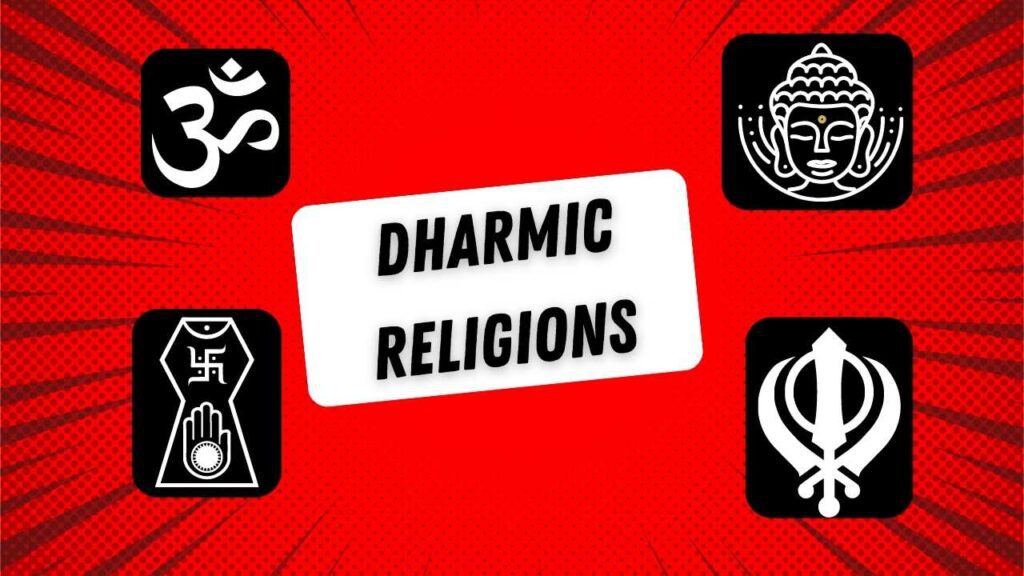Dharmic religions originate in India’s subcontinent and encompass an assortment of spiritual traditions with common principles, philosophies and practices known as Dharma – from Sanskrit meaning “to uphold or support.” Dharma emphasizes righteousness, duty and moral conduct – so in this article, we’ll take an in-depth look at dharmic religions and their key features.

Contents
Dharmic Religious Teachings Are Based Upon Four Key Elements
Hinduism, Buddhism, Jainism and Sikhism are four of the main dharmic religions, each emphasizing the eternal laws of nature such as karma (cause and effect) and reincarnation (belief in rebirth). All four faiths aim to attain Moksha or Nirvana for ultimate liberation from birth and death cycles.
Core Beliefs and Practices of NAOSD.
Hinduism:
Hinduism, as one of the oldest dharmic religions, is vast and varied. It embraces many deities, rituals and scriptures pertaining to Brahman (the ultimate reality), Atman (soul), Dharma and Yoga are fundamental parts of their lifestyles and life path.
Buddhism:
Buddhism was established by Siddhartha Gautama and centers around four Noble Truths that address human suffering while prescribing an Eightfold Path towards spiritual enlightenment. Meditation forms an integral part of Buddhist practice and leads to an increased understanding of reality itself.
Jainism:
Jainism advocates nonviolence (Ahimsa) towards all living beings. Jains adhere to a stringent code of ethics and practice ascetic practices to gain spiritual purity. Jain philosophy centers around the concept of soul (Jiva) and matter (Ajiva), with liberation (Moksha) being its ultimate aim.
Sikhism:
Sikhism, founded by Guru Nanak, encourages devotion to Ik Onkar (one supreme reality). Sikhs follow the teachings of Ten Gurus and the Guru Granth Sahib as their holy scripture. Compassion for humanity and devotion towards divinity are central components of Sikhism.
Rituals and Festivals Dharmic religions celebrate an array of festivals that each have unique cultural and spiritual meaning. Diwali is celebrated widely across Hinduism and Sikhisim to symbolize the triumph of light over darkness; Holi marks spring’s arrival while also symbolizing good over evil; Holi also marks springtime’s arrival while representing victory of good over evil; Holi also has great religious significance to Jain communities while Buddhists observe Vesak to commemorate Gautama Buddha’s birth, enlightenment and death while Jain festivals like Mahavir Jayanti celebrate his life and teachings while Jain festivals like Mahavir Jayanti celebrate his teachings while Jain festivals such as Mahavir Jayanti honor the life and teachings of Lord Mahavira himself.
Dharma serves as the moral compass in Dharmic religions, providing adherents with direction in their actions and choices. Dharma emphasizes leading a righteous life while fulfilling duties to all living beings with compassion and respect. For Hinduism followers, their Dharma can be determined by caste, age, occupation and other factors; for Buddhists Dharma stands in for his teachings while for Jains this path encompasses faith, knowledge, and conduct – making dharma central to every religion’s Dharmic religions.
Journey To Liberation
Dharmic religions aim to achieve liberation from the cycle of birth and death by attaining eternal blissful union with the divine, leading to an eternity of happiness and spiritual bliss. This journey involves self-realization, inner transformation and detaching oneself from worldly desires – through sincere devotion, meditation and righteous living adherents hope to attain their highest spiritual realization.
Conclusion
Dharmic religions represent an array of spiritual beliefs and practices connected by Dharma. Hinduism, Buddhism, Jainism and Sikhism each offer profound insight into existence, karma and liberation from life’s cycle; compassionate wisdom service are core tenets in their practices and provide a roadmap towards meaningful living that fulfills spiritually. Their festivals rituals and philosophies continue to offer inspiration worldwide and thus form part of global spiritual landscape.
This article covers Dharmic religions in a straightforward, uncomplicated style. The term “Dharmic religions” appears prominently throughout, appearing as subheadings, the beginning content and within 10% of it; its focus length is 700 words long with paragraphs between 100-120 words each and making SEO-friendliness a consideration. Overall this provides a basic overview of dharmic religions adhering to guidelines provided.
Indian Sub-Continent Origins – World Religions
Related Post:
Sprite Mythology: Unveiling Ethereal Beings’ Bewitching World
Ancient Egyptian Religion Unveiling the Enchanting Secrets – 7 Fascinating Aspects to Explore
Sacred Bombshell Guide Empowerment Spirituality Love Wellness









